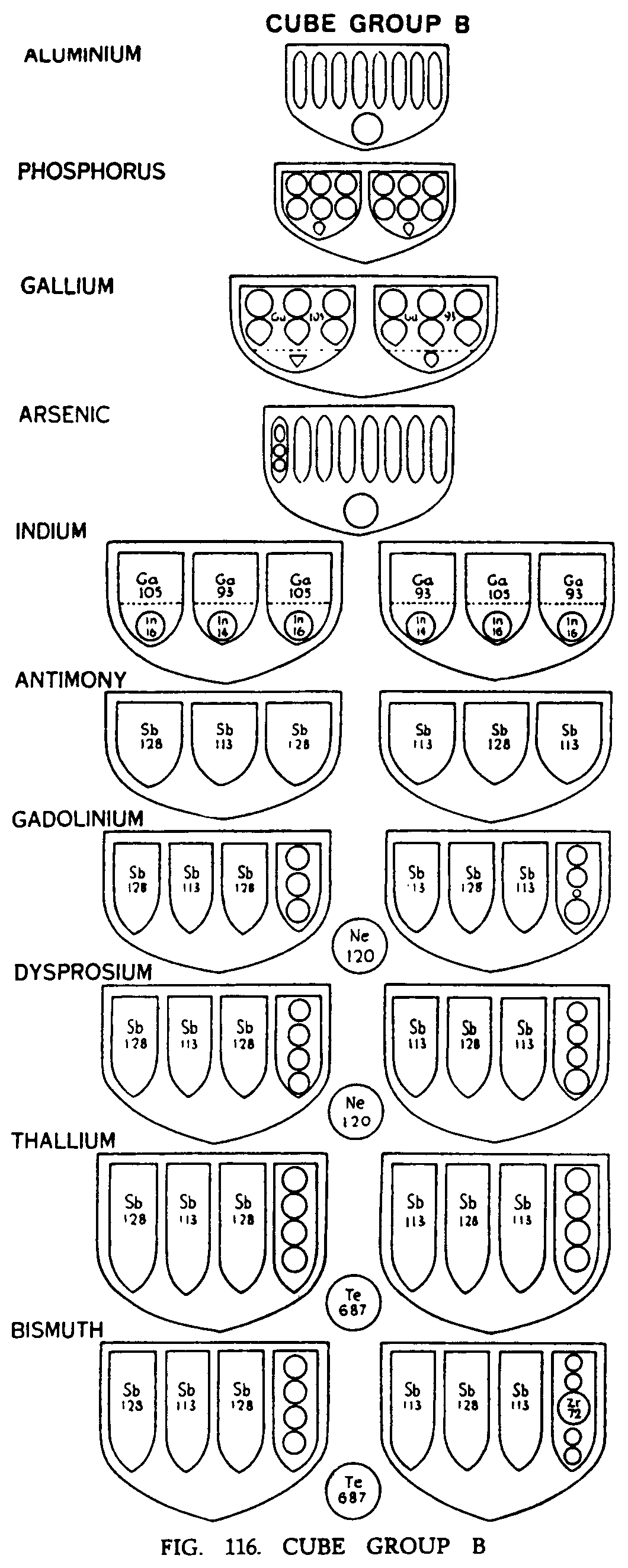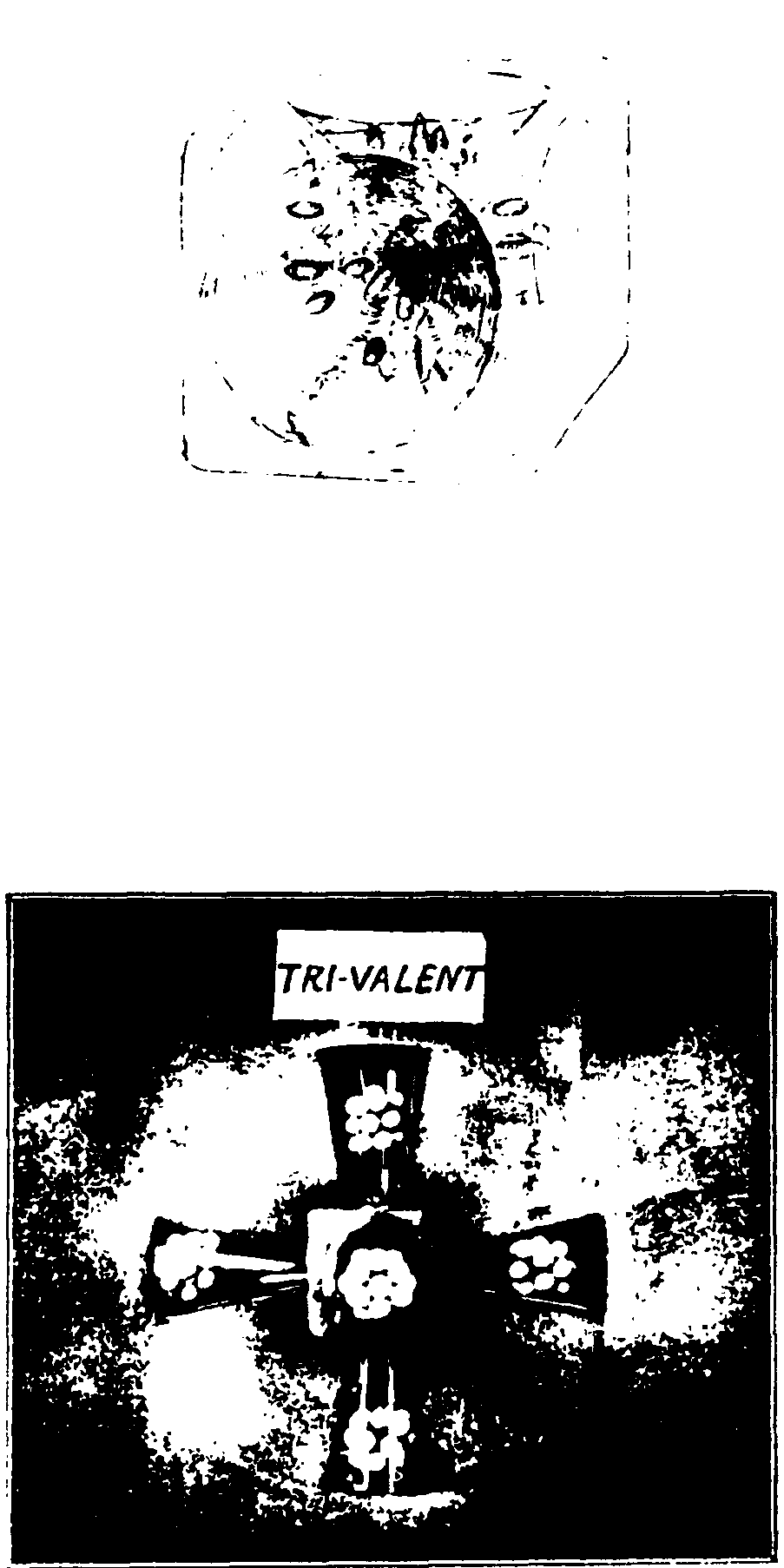
FIG. 97. TYPES OF CUBES

ATOMIC
ANU ELEMENT CENTRE b FUNNELS
NO.
13
486 Aluminium - 6[AL9'+8AL9]
15
558 Phosphorus -- 6 [ (B5+3N6+ 3P9)+ (Li4+3Be4+3P9)]
31
1,260 Gallium - 6[(Ga7+3Ga15+3Ga20)+(B5+3Ga13
+3Ga18)
]
33
1,350 Arsenic - 6 [A1.9'+8(2N9+A1.9) ]
49
2,052 Indium - 3 [2 (In16+3Ga15+3Ga20)+(In14+
3Ga13
+ 3Ga18) ]
3
[ (In16+3Ga15+3Ga20)+2(In14+
3Ga13+3Ga18)
]
51
2,169 Antimony - 3 [2Sb128+Sb113]
3
[Sb128+2Sb1131
64
2,880 Gadolinium Nel20 3 [2Sb128+ Sb113+ (Ca45+2N24) ]
3
[Sb128+2Sb113+(Ca45+Moll+
2N24)
]
66
2.979 Dysprosium Ne120 3 (256128+Sb113+(Ca45+2Mo11+
2N24)
]
3
[Sb128+2Sb113+(Ca45+2Mo11+
2N24)
]
81
3,678 Thallium 71.687 3 [2Sb128+Sb113+(Ca45+T1.44+
2N24)
]
3
[Sb128+2Sb1i3+(Ca45+T1.44+
2N24)
]
83
3,753 Bismuth T1.687 3 [2Sb128+Sb113+(Ca45+Mo46+
2N24)
]
3
[Sb128+256113+ ['Ti+88+(Ga20
+
4Zr13) ~ ]
178
OCCULT CHEMISTRY

FIG.
98. ALUMINIUM. PHOSPHORUS
As
the head of the group this element is, as usual, simple. There is no central
globe. Fig. 98.
Funnels.
The
six funnels each contain eight similar ovoids, AL9, of three spheres of
three Anu. Below these is an ovoid A1.9', again of three spheres, these
being two duads and a pentad.
Aluminium = 6 (A1.9'+8 AL9)
Segment
A contains at the bottom a group 135, then three N6, and then three spheres,
P9, of nine Anu, making 50 Anu in all. Segment B also contains seven spheres,
first a tetrad Li4, with its Anu at the corners of a tetrahedron, then
three spheres of four Anu, Be4, and then the three spheres, P9, of nine
Anu found in segment A. Segment B contains 43 Anu.
Phosphorus
= 6 ( (B5-f-3N6-I-3P9) + (Li4-t-3Be4+3P9)]
6
funnels of 93 Anu = 558 Anu
180
OCCULT CHEMISTRY

FIG.
99. GALLIUM. ARSENIC
Gallium
--- 6 [( Ga7-1-3Ga15+3Ga20)-t-(B5+3Ga13-f-3Ga18)]
6
funnels of 210 Anu -- 1260 Anu
Arsenic
--- 6 [A1.9'+8 (2N9-1-AL9)]
6
funnels of 225 Anu 1350 Anu
182
OCCULT CHEMISTRY
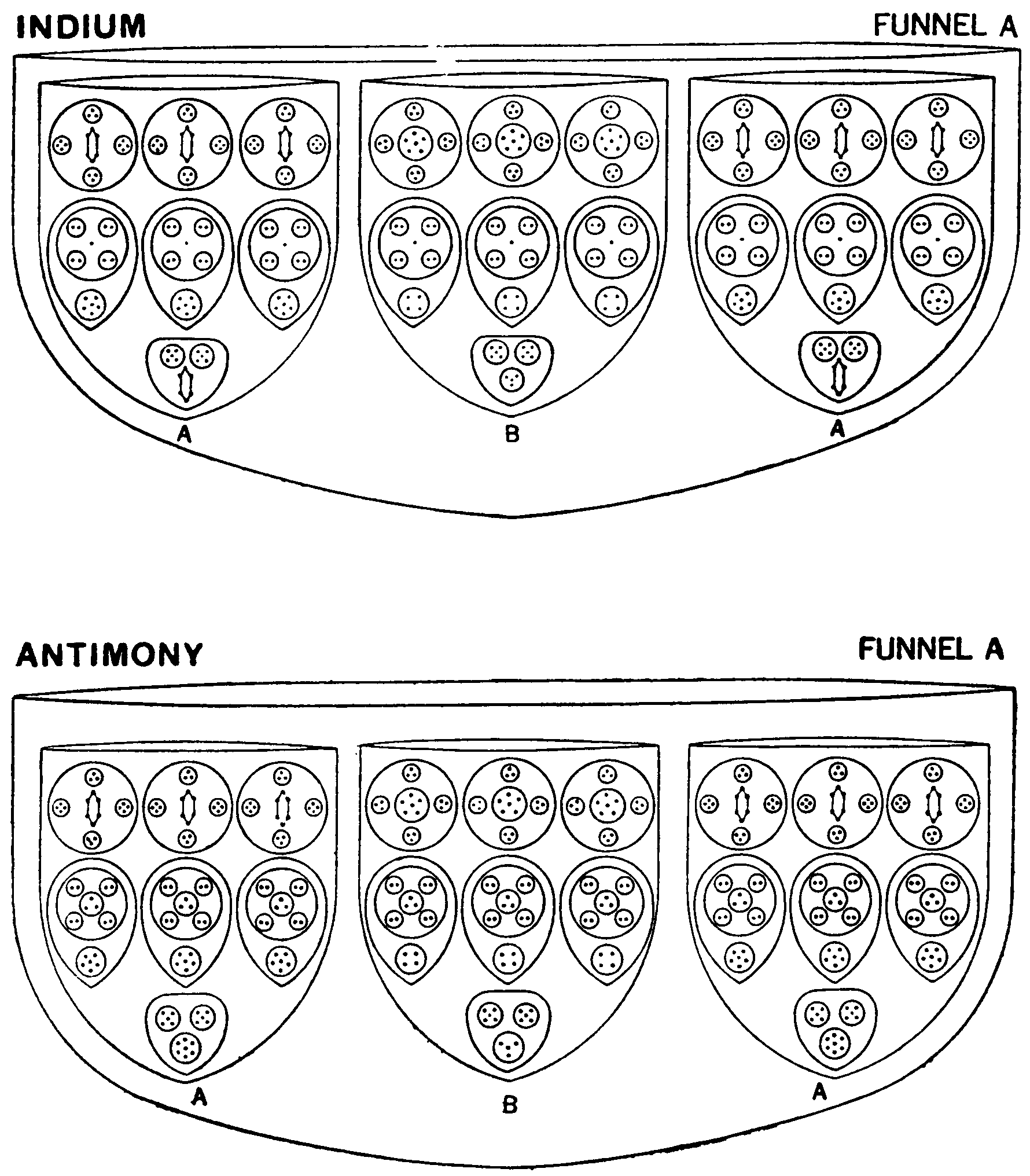
FIG.
100. INDIUM, ANTIMONY
Indium
= 3 [2 (In16+3Ga15+3Ga20)+(In14+3Ga13+3Ga18)]
+3
[ (In16+3Ga15+3Ga20) +2 (In14+3Ga13+3Ga18)]
3
funnels 2A+B = 1047 Anu
3
funnels A+ 2B = 1005 .,
Total
= 2052 Anu
Number
weight ~82 = 114.0
ATOMIC
NO 51 ANTIMONY
Segment A consists of seven bodies. Nearest the centre we find a group containing two quintets and a septet L7. This group may be identified as Sb1T. Then comes a ring of three spheres containing 17 Anu, Sb17. In this sphere we find that the unit in the centre of the P9 group has been replaced by a triplet. Finally there is another ring of three globes each containing two triplets, two quartets and an Ad6. This is Ga20. This whole segment is Sb128. Segment B also contains seven bodies, first a group of three small spheres which is identical with In14, then a ring of three Sb15, and finally three Ga18, the whole making Sb113.
So in Antimony we find three funnels of Type A containing 2A + B segments and three funnels of Type B containing A+2B.
Antimony
= 3 (2Sb128+Sb113)+3 (Sb128+2Sb113)
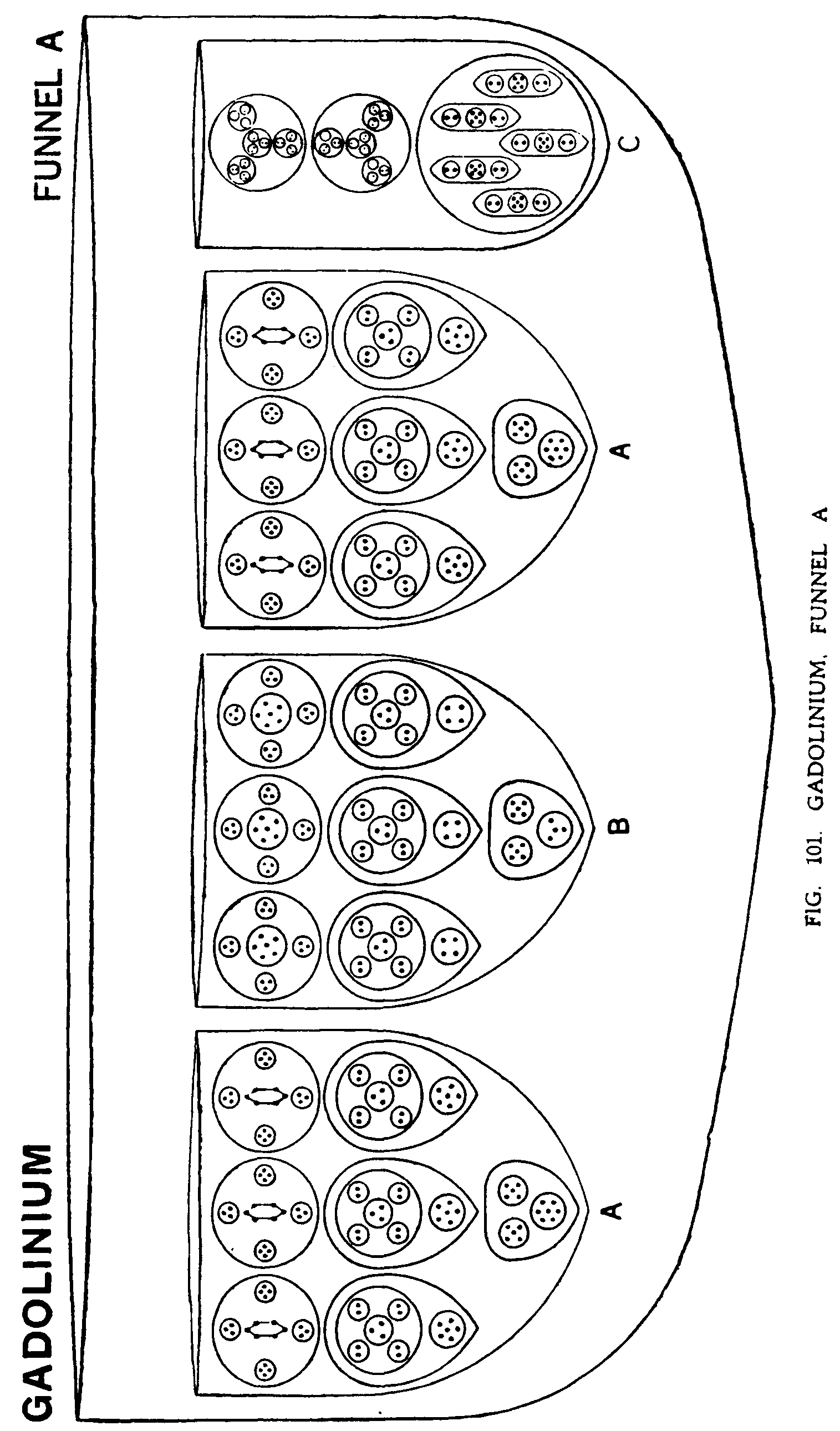
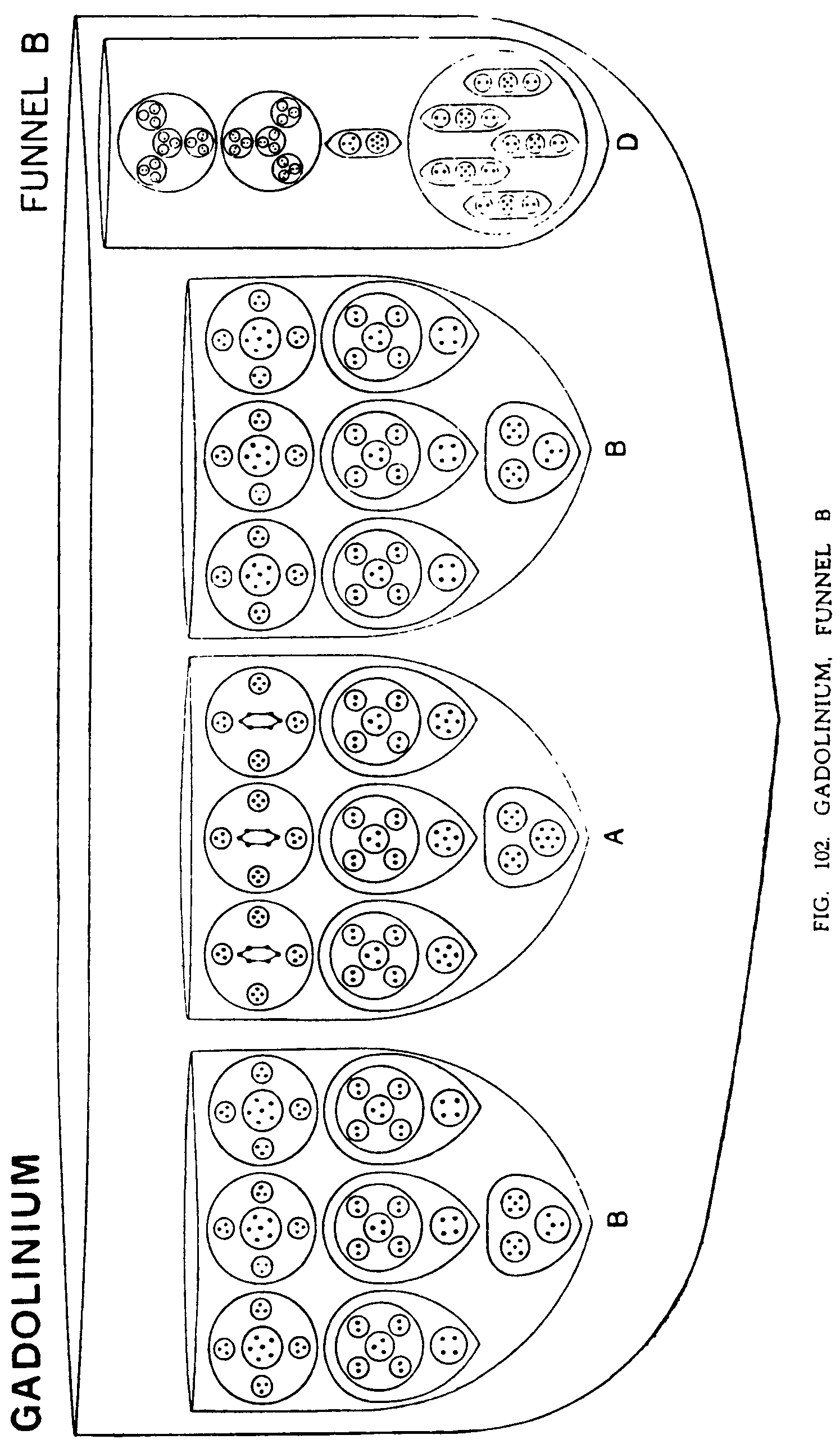
186 OCCULT CHEMISTRY
ATOMIC
NO. 64. GADOLINIUM
Funnels. Gadolinium has two types of funnels, each of which contains four segments. Figs. 101, 102.
In three of the funnels we find that segments A, Sb128, and B, Sb113, are identical with those of Antimony. Segment C contains one Ca45 and two N24 spheres making up 93 Anu, Gd93. In this first set of funnels there are 2A+B+C segments.
containing
Ca45, 2N24 and an additional group Moll, making up Gd104. Thus these
tunnels
are made up of A+2B+D.
Gadolinium
- Nel20+3[2Sbl28+Sbll3+Gd931
+3[Sb128-f-2Sb113+Gd104]
Central
globe = I2(T Anu
3
funnels (2A+B+C) = 1386 _
3
funnels (A+2B-f-D) = 1374 _
Total
= 2880 Anu

Central
globe. The central globe is formed of the five interpenetrating tetrahedrons
as in Gadolinium, Ne120. Fig. 104.
Funnels.
The
six funnels each contain four segments and these are of three types. Segment
A is Sb128, Segment B is 56113, Segment C is Gd93 with the addition of
two Moll groups, making Ds115. Figs. 105, 106.
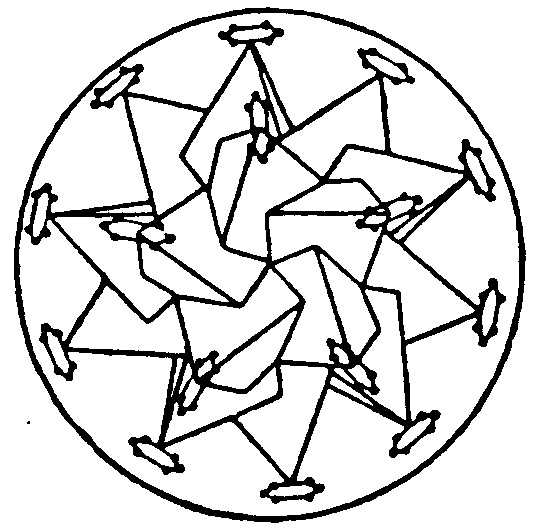
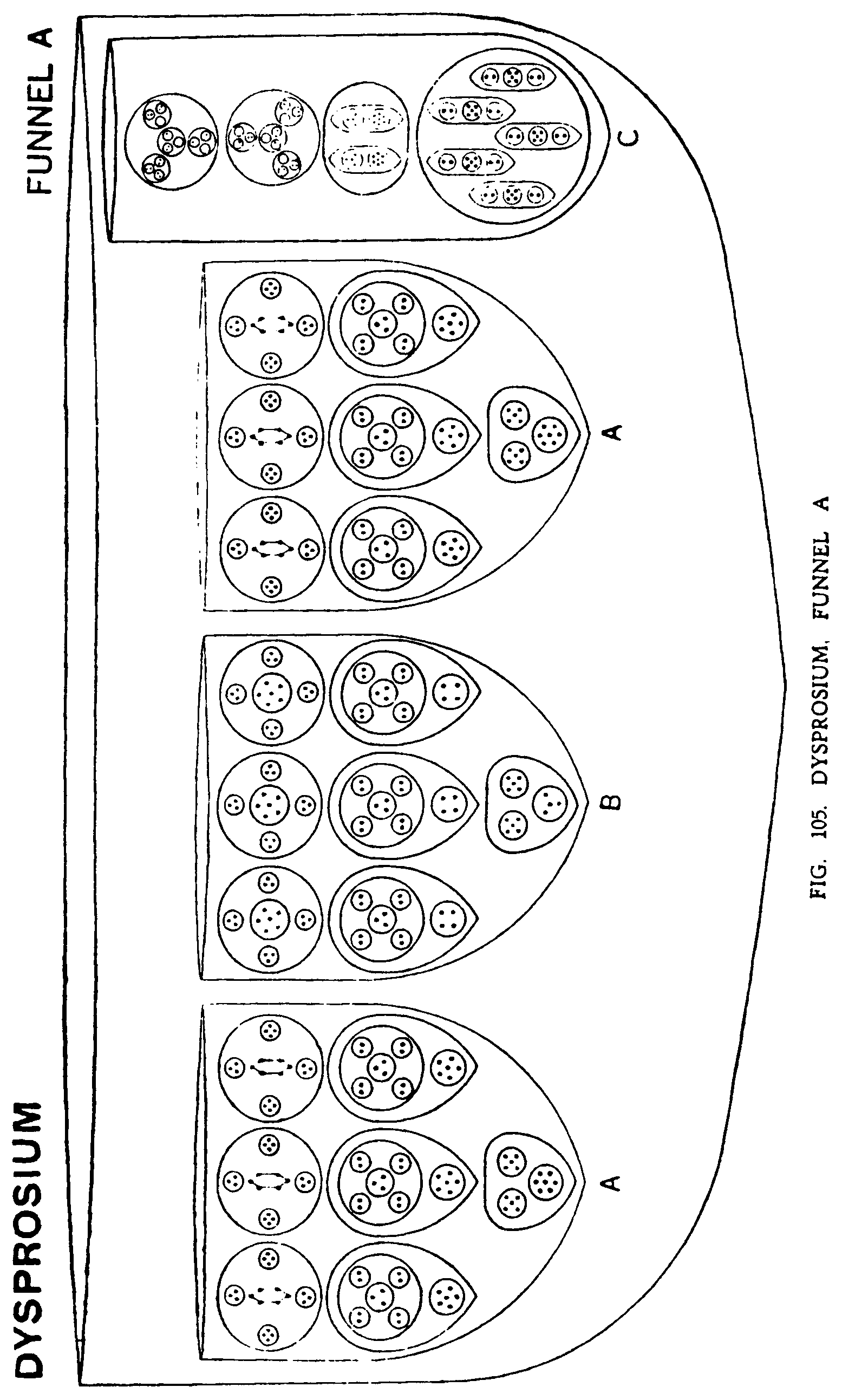


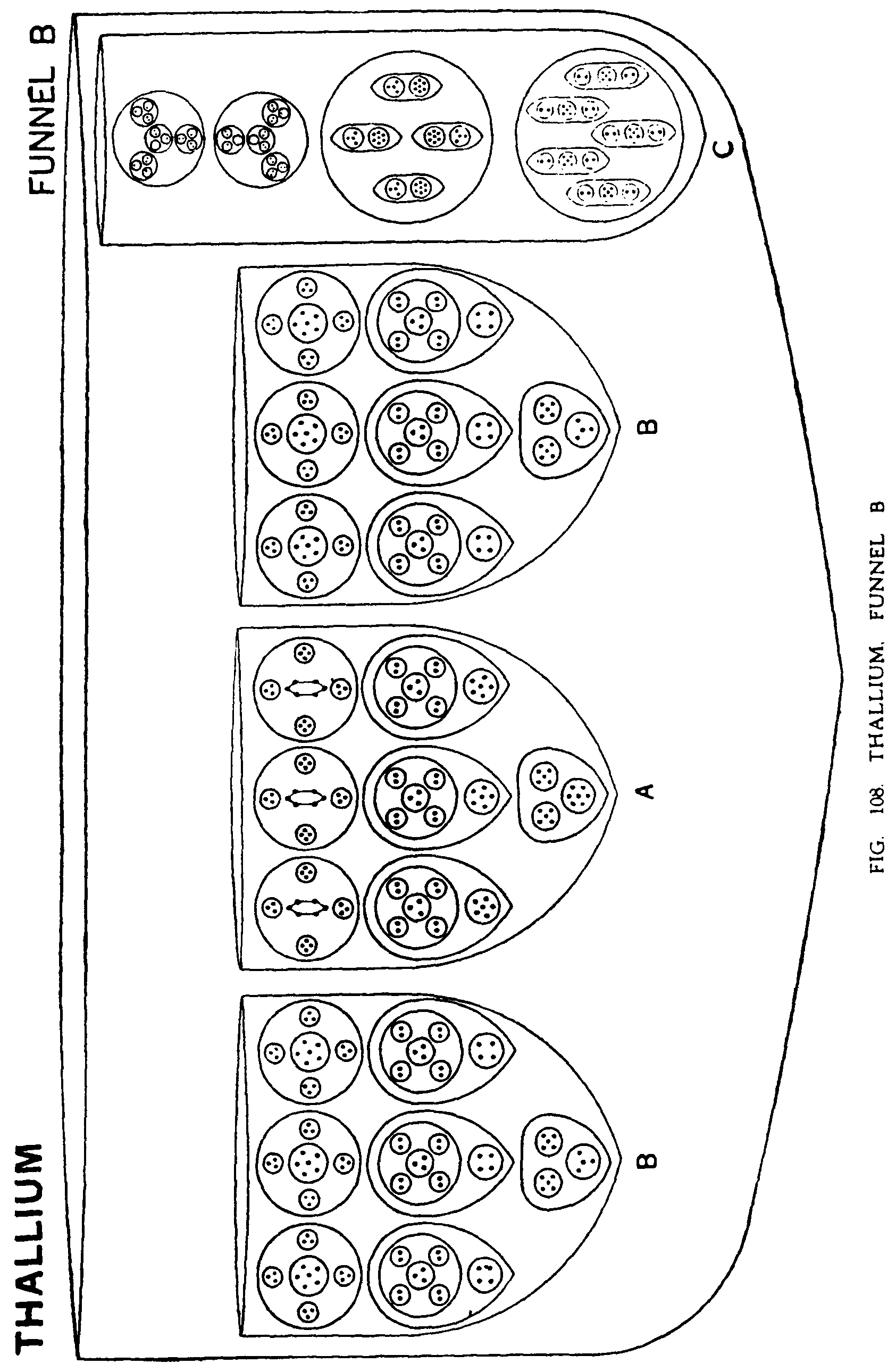
192
OCCULT
CHEMISTRY
ATOMIC
No. 81. THALLIUM
Central globe. There is here a central globe very similar to that in Cerium. It consists of a central group, Ce27, surrounded by 20 ovoids of 33 Anu, making 687 Anu in all. Fig. 109.
Funnels. Here again we find two types of funnels. Each funnel contains four segments made up of types A, B and C. Segment A is Sb128, segment B is Sb113, and Segment C contains Ca45, plus a sphere containing four Moll, T1.44, and then two N24, making 71.137. Figs. 107, 108.
Central globe. The central globe is similar to that of Thallium, T1.687. Fig. 109. Funnels. Here again there are two types of funnels, each containing four segments, made up of types A, B, C and D. Segment A is Sb128, segment B is Sb113. Segment C is composed of Ca45, Mo46 and two N24 groups making 139 Anu. Segment D is part of the arm of Zirconium and contains 160 Anu. Three of the funnels contain 2A-f-B+C and three A+2B-f-D. Figs. 110, 111.
Bismuth
== T1.687-f-3(256128-i-Sb113-f-(Ca45+Mo46-E-2N2f1)
-f-3[Sb128+2Sb113-f-_Ti88-f-(Ga20+4Zr13)1]

FIG.
109. THALLIUM AND BISMUTH CENTRE, TL687
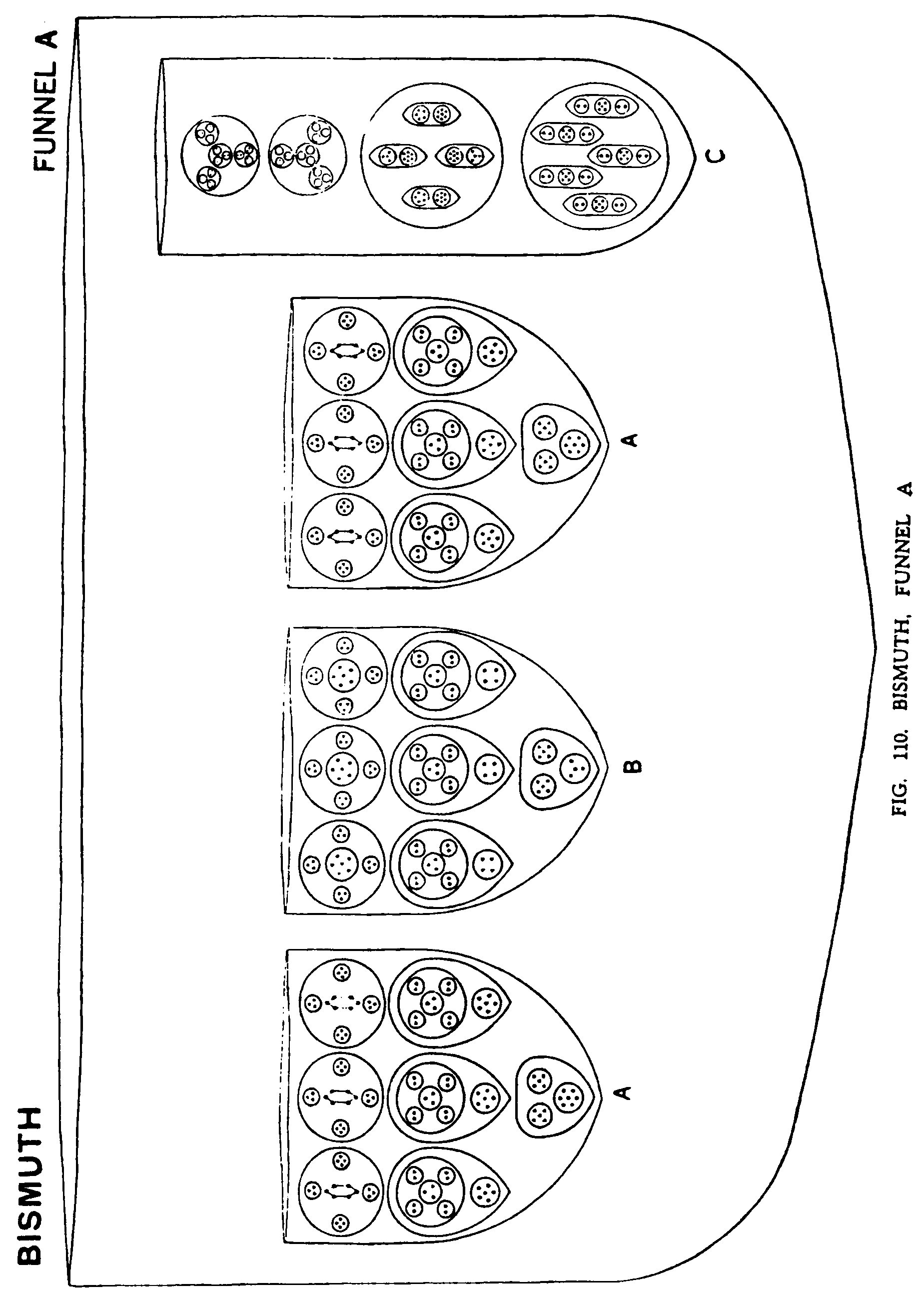
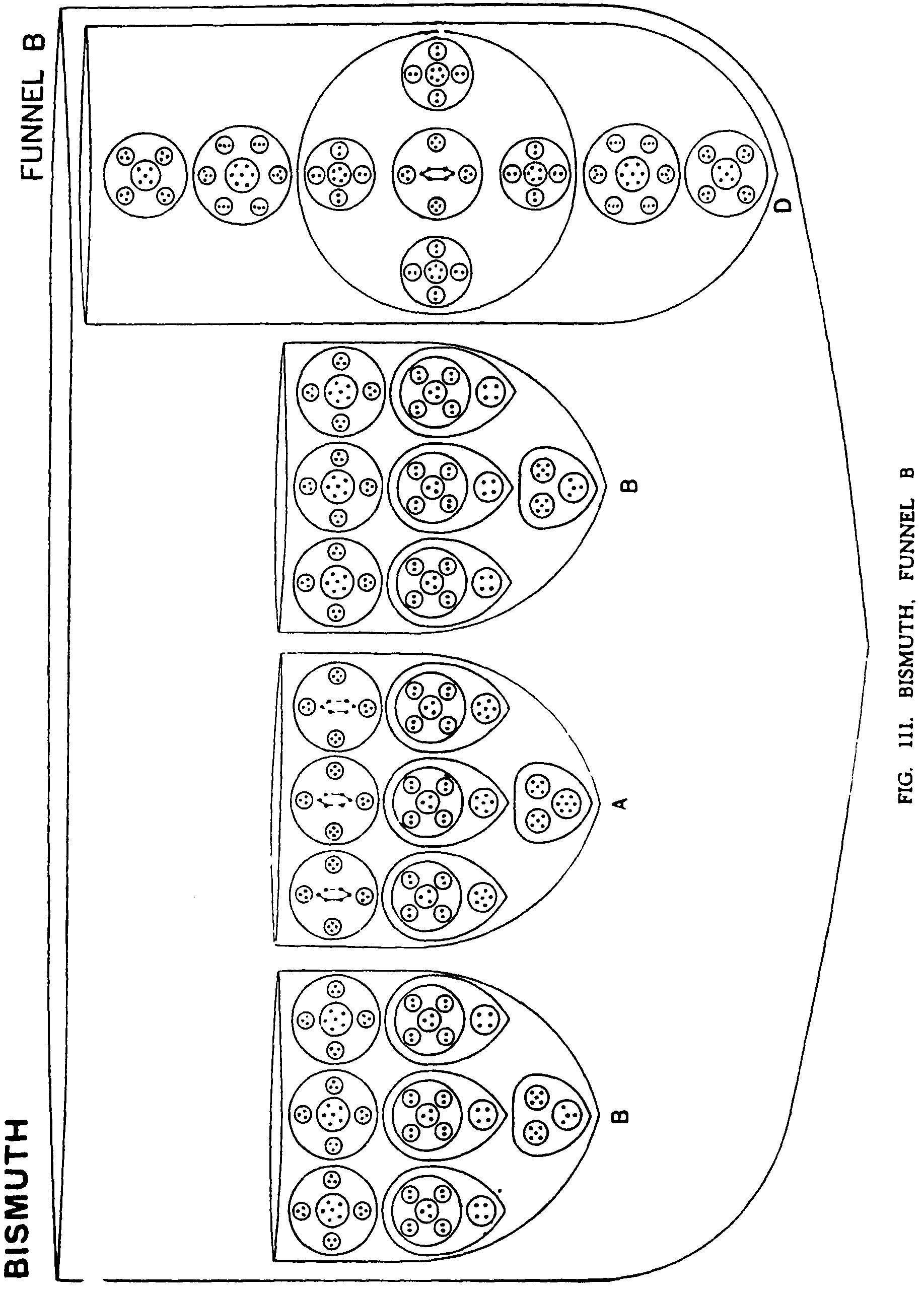
196
OCCULT CHEMISTRY
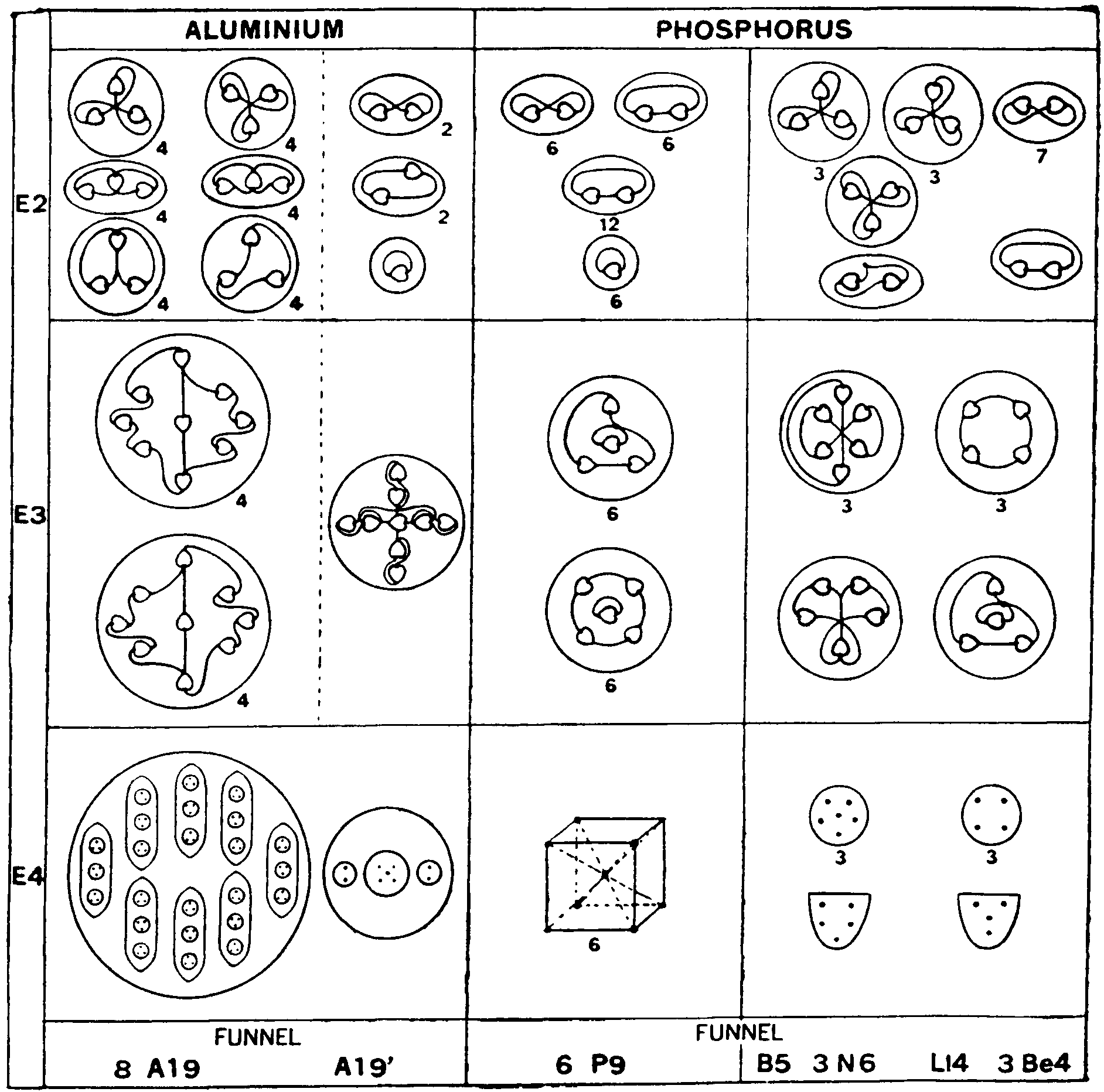
On the E3 level the eight ovoids are set free and become spherical. forming bodies containing 9 Anu as shown in Fig. 112.
Similarly segment B, on the E4 level, liberates three P9, three quartets, Be4, and one quartet, LA.
On the E3 level the P9 groups each form two bodies. Five of the nine Anu hold together and place themselves on the angles of a square-based pyramid; the remaining four set themselves on the angles of a tetrahedron. The other groups form three sextets, and a quintet and three ring quartets and a pyramid as shown.
On the E2 level each P9 yields 4 duads and a unit, while the other groups form triads and duads as shown.
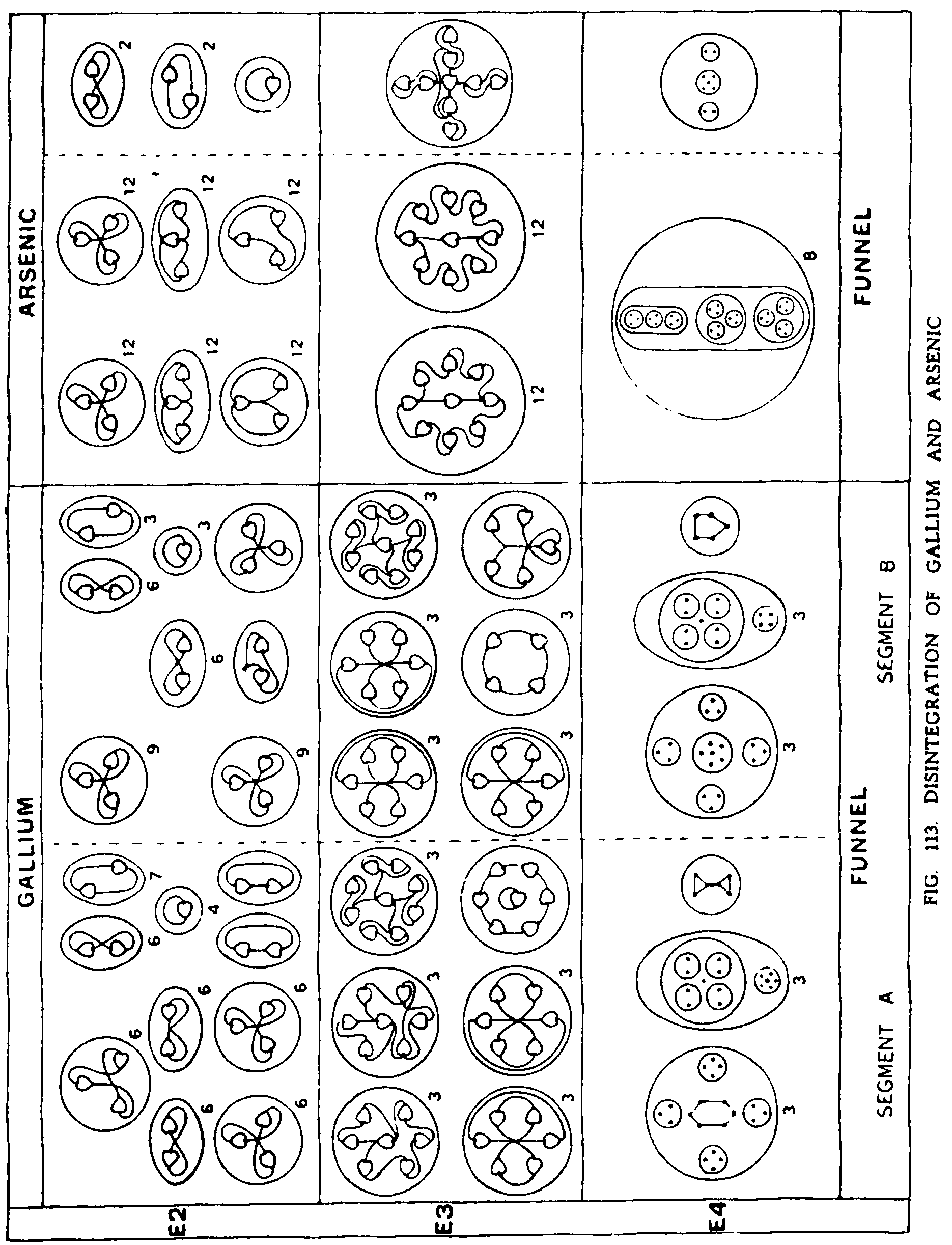
In Gallium the funnels are liberated and then set free their two containing segments, each of which forms a cylinder. Thus each funnel yields two bodies at the first stage of the E4 level. This is not shown in Fig. 113. At the second stage the segments liberate their contents, each giving seven groups. Fig. 113.
Segment A. On the E4 level this gives the three Ga20, three Ga15 and the small group of 7 Anu, Gal.
On the E3 level each Ga20 forms a sextet and two septets, the quartet and triad uniting. Each Ga15 forms a sextet and a cross with nine Anu having a duad in each arm and one Anu in the centre. The Gal forms a ring of six Anu with one in the centre.
Arsenic resembles Aluminium in having eight ovoids in its funnel. These are set free as spheres on the E4 level, as is the globe of nine Anu, A1.9'. Thus we have nine spheres on this E4 level. Fig. 113.
On
the E3 level the three groups of nine Anu from the ovoids are liberated
and form groups having the same design as those in Aluminium. The
globe AL9' gives a cross of nine Anu. On the E2 level triads, duads and
units are formed at shown in Fig. 113.
200
OCCULT CHEMISTRY
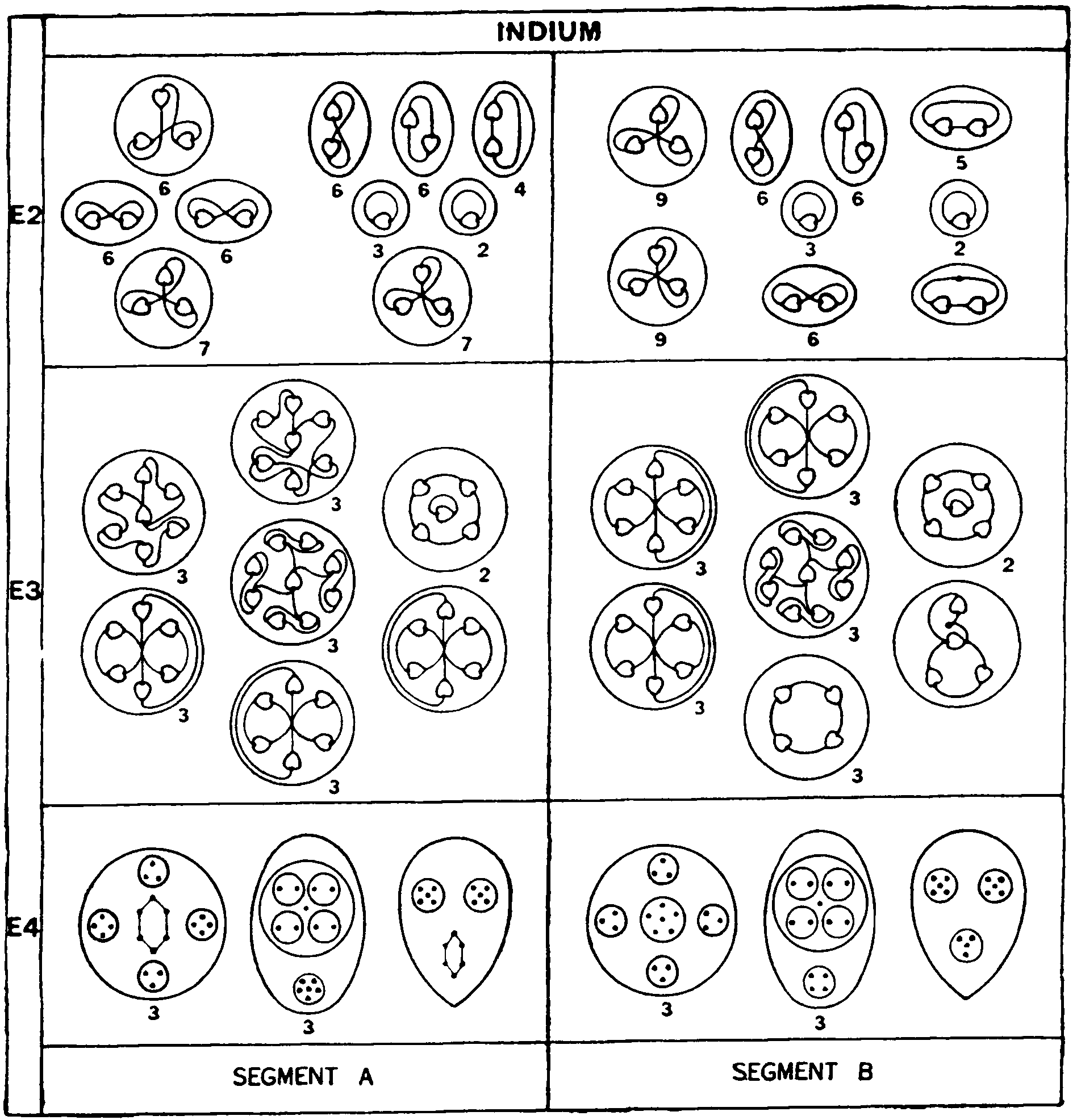
On
the E3 level each Ga20 gives a sextet and two septets as before. The Ga15
also acts as in Gallium giving a sextet and a cross of nine Anu. The In16
gives a sextet and two quintets formed of a ring of four Anu with one in
the centre (a squarebased pyramid).
On
the E3 level each Ga18 gives three sextets and the Ga13 gives the cross
of nine Anu and a ring quartet as in Gallium. The In14 gives a tetrahedron
quartet and two quintets (square-based pyramids).
202
OCCULT CHF.IMSTRY
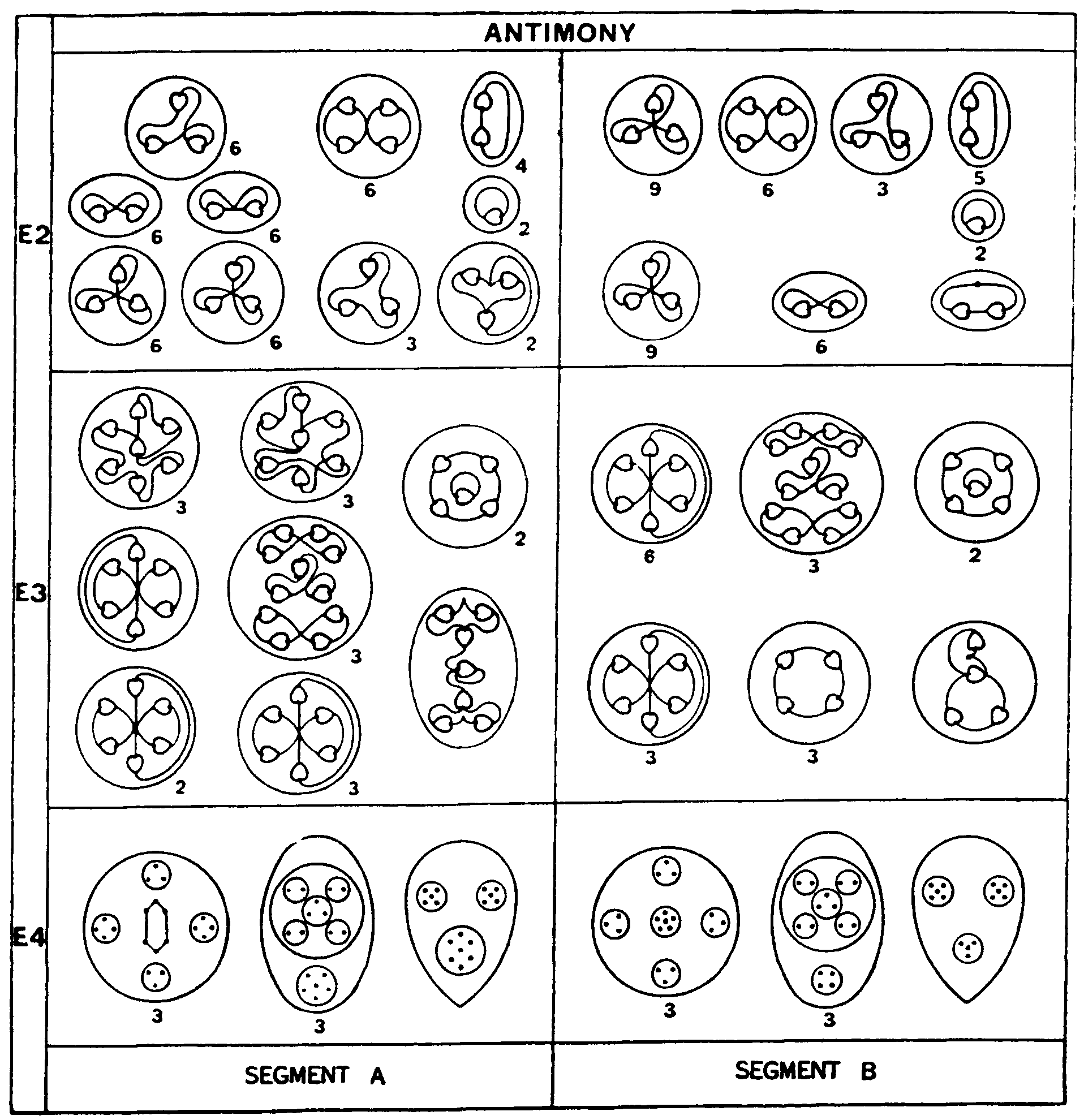
This element follows Gallium and Indium in its disintegration. There are three segments in each funnel and these segments are of two types. Each liberates seven bodies on the E4 level. Fig. 115.
Type A. On the E4 level we find three Ga20, three Sb17 and one Sb1T. On the E3 level each Ga20 gives a sextet and two septets. The Sb17 is like the Ga15 except that a triplet is substituted for the unit in the centre of the P9 group. This apparently throws the cross out of gear for we have a new figure of eleven Amu containing two quartets and a triplet. In addition to the body of eleven Anu each Sb17 liberates a sextet on the E3 level. The Sb1T gives a septet and two quintets of the square-based pyramid type.
204
OCCULT CHEMISTRY
Fig. 116 shows the Cube Group B in a condensed form, from which the relationships in the group can be studied.
